
This piece was the winner of the 2016 writing contest.
(CONTAINS GRAPHIC IMAGES. VIEWER DISCRETION ADVISED.)
The yellow and white stadium loomed above us, The Plaza de Toros de la Maestranza is what they called it. We shuffled through the crowd and past vendors selling hats and fans and waters. It was only six o’ clock but it was still almost 100 degrees outside. I bought myself a giant water bottle for two euros. It was a steal compared to the six-euro bottles we usually found on the streets. It sweat in my hand as I followed the rest of my group into the stadium.

We found our seats, which were really just concrete slabs, all in the same row. I got the last seat of the group and had the privilege to sit next to a large Spanish man with white hair and a white beard who sat with his arms crossed. I could tell he was not amused by the four American girls who sat next to him. He scooted ever so slightly away from me as I took my seat. I looked around the arena, and noticed that there were not many women here. My gaze was met by Sevillano men dressed in khakis and pastel button downs, some with hats, some without, and some holding small white towels. Many of them seemed in an excited conversation as they pointed to their programs. I searched harder and found a handful of women. They wore sundresses or dress pants with nice blouses. Some of them also had hats, only theirs were bigger than the men’s and they sat fanning themselves.
The late afternoon sun beat down on us. The back of my legs began to sweat. I looked down the row and waved to Brittany, who sat on the end and then I waved to the rest of the seven members of our group who sat across the aisle. I was the only one excited for this corrida or bullfight in English. It had always been on my bucket list of things to do if I ever got the chance to go to Spain. As an avid traveler I knew how important it was to really experience the culture and immerse myself. One of the best bullrings to see a corrida was right here in Seville after all. How could I pass up this opportunity? There was an excitement in the air that reminded me of the kind of energy you feel before a horserace. Do people put money on the matadors? The bulls? I remember wondering. I could tell something was happening here aside from the slaughter of six bulls.
Originally scheduled to go to a corrida on Sunday, our professor, María Muñoz, told us that Wednesday nights were apparently “the nights” to see a bullfight. It was said that the biggest bulls and the best matadors performed on Wednesdays. I squirmed anxiously in my seat as I waited for the corrida to begin.
A parade of the participants, paseillo emerged from the gates on the other side of the arena. This is it. It’s really starting. As is tradition, two alguacilillos, dressed in a 17th century costume lead the parade on horseback, followed by three toreros, also called matadors. The three men are lined up according to seniority. The matador on the right is the senior, the one on the left is the least experienced and the one in the middle is the intermediate. After the matadors comes the banderilleros, who are also lined up according to seniority. The banderilleros are the members of the matador’s cuadrilla who are responsible for placing the banderillas, a long decorated barbed dart, into the bull’s neck or shoulder muscles during a fight. Following the banderilleros comes the picadores, forming pairs, riding their horses. At the end of the parade comes the mozos de caballosand the areneros, followed by the mules and the mulilleros. The areneros are in charge of cleaning and keeping the sand in good condition. They are typically dressed in a green shirt and dark blue trousers. The mulilleros are the men who manage the mules that drag the dead bull out of the arena. They wear a white shirt and dark blue trousers.
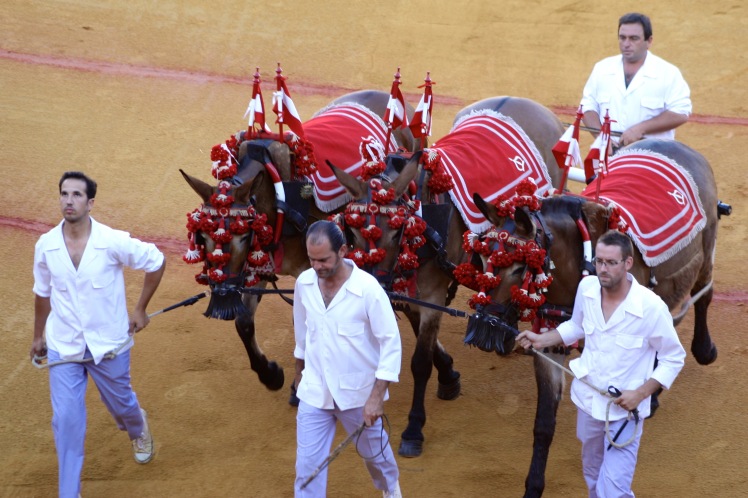
Once all of the participants had entered the ring in an array of colorful clothing, the bugle sounded to announce the first fight. I would soon learn that this bugle was the bugle that sounded the end to each of the three stages of the fight. Each stage, or tercio, lasts approximately twenty minutes.
The first stage is called the tercio de varas, the second, tercio de banderillas, and the third, tercio de muerte. The first stage, tercio de varas, means the “third of lances”. This stage is where the matadors and banderilleros test the bull and observe its behavior and ferocity through a series of passes. Next, two picadores, bullfighters on horseback will enter the arena with lances to be stabbed into the back of the bull’s shoulders. The blood loss helps tire the bull, making his charges less dangerous to the matadors.
The first bull came out of the shoot and ran into the arena at top speed with such ferocity I couldn’t imagine going up against one. Filiberto was the first matador to go, having seniority in experience. He was twenty-one years old. I would later find this information in a program that somebody had left behind. When the bull saw the matador he charged in his direction and went right for the fuchsia and yellow capote, the large cape that toreros carry with both hands. Finding nothing on the other side of the cape, the bull first looked around confused, then charged back at the matador. The matador continued to perform stylistically charged passes. The pair danced like this for some time before a bugle sounded, signaling for the picadors to enter the ring.
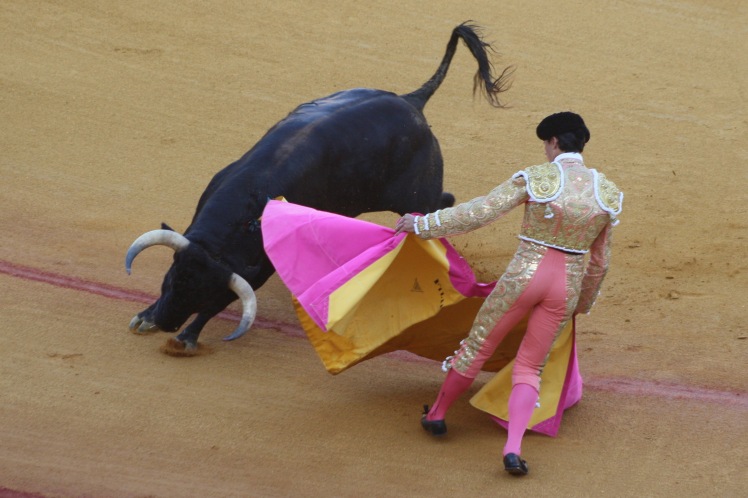
The bullfighters on horseback walked their horses along the outside of the ring purposefully and proudly. The horses were covered in a thick body suit to protect them from the bull’s horns and they were blindfolded so they wouldn’t spook as the bull approaches. Once the picadors were on opposite sides of the ring, the matador positioned the bull in the center of the ring, facing the picador farthest from the gate where they entered. The rider began shouting and moving his horse to provoke the bull. The bull snorted and charged, as he closed in on the horse, the picador took his lance, no more than eight and a half feet long, with a short pyramid-pointed spike a little more than an inch long and jabbed it into the large shoulder muscle of the bull called the morrillo.
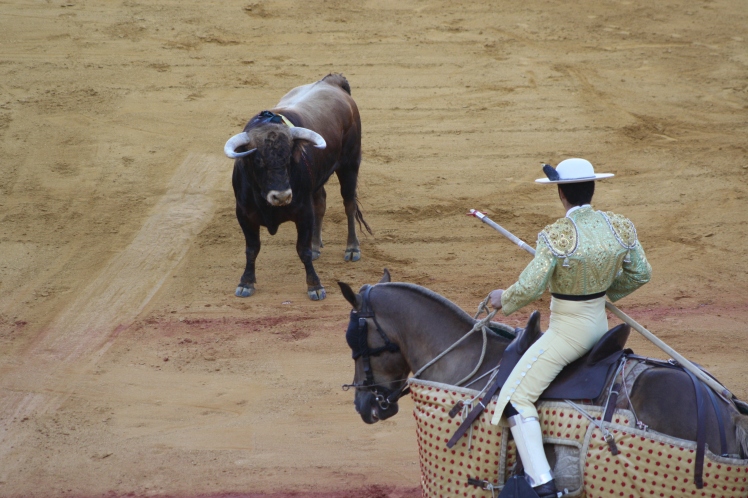
Jordyn and Ally whimpered next to me as the bull ran into the horse, moving it slightly. As an equestrian, my heart skipped a beat as I saw this, but I knew that the horse was protected and although I also knew the bull could topple the horse over if he really wanted to, I believed that it wouldn’t happen. Believing this made it easier to watch. Ally, my equestrian teammate, ducked her head into Jordyn’s shoulder. I continued to take pictures.

The bull charged again, and the picador jabbed his lance into the bull again. As a result of this process, the bull will carry his head lower which will help the matador in the final stage. The matador lured the bull back into he center of the ring where they danced through several passes. As artistic as this looked, the matador was really assessing the bull’s condition and the damage of the “pics”. Satisfied, the picadors left the ring. The trumpets sounded again, signaling the second stage.
The second stage, tercio de banderillas, means the “third of flags”. This stage is where the three banderilleros plant two banderillas, the sharp barbed sticks, into the bull’s shoulders. Each banderillais over two feet long with a blade that’s about an inch and a half in length. Since the blade is barbed, the banderillas stick in the bull’s skin. After provoking the bull to charge head on, they are placed, in pairs into the muscle on top of the bull’s shoulders. Banderillas are usually placed in three pairs to complete the tercio. The banderillas further weaken the bull and also further anger it, encouraging more ferocious charges.

Next to me, Jordyn had begun to cry, and Ally covered her mouth looking on in horror. The banderilleros ran towards the bull in a curved line, and when they crossed paths with the bull, the banderillero leaned over the horns and placed the banderillas. It amazed me how none of them were gored by the bull especially since they didn’t have any protective gear like the horses and were being charged straight on, unlike the matadors who are usually charged at from off to the side. The bull circled the ring, banderillas bouncing off its shoulders. Trumpets sounded again signaling the third stage.
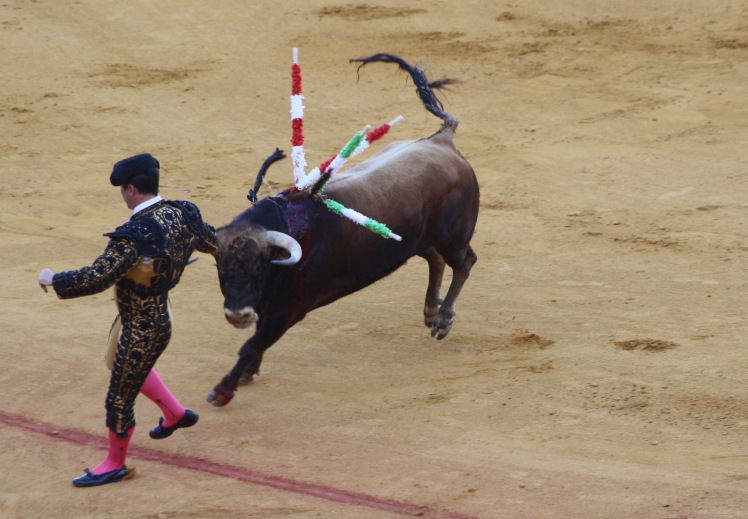
The third stage, tercio de muerte, means the “third of death”. This is probably the most iconic phases of the corrida. This stage is where the matador has his one-on-one encounter with the bull. The matador holds a red cape or muleta stretched over a wooden dowel in one hand and a sword in the other. The muleta is smaller and lighter than the capote. The matador will first hold an imitation sword, made of wood or aluminum, used to extend the fabric and increase the size of the cape when giving right-handed passes. Later, this sword will be exchanged for a real sword made of steel. The matador has a total of fifteen minutes to kill the bull once the first pass is performed. Eventually, after a series of various passes, the matador will exchange his aluminum sword for a real one and maneuver the bull into a position to kill it by thrusting the sword between the bull’s shoulder blades and through the heart.
The audience fell silent with anticipation. The bull stood before the matador sides heaving and bloodied. The matador stood directly in front of the animal, right between the horns, holding the muelta to the bull in his left hand and letting out a loud vocal outcry that broke the silence that had fallen over the bullring. The bull charged, head lowered, the matador took a step towards the beast. I heard the faint tinkling of bells. The bells of death. These bells belonged to the mules that would carry out the deceased bull. When I heard them, I knew that the bull’s time was coming to an end. As the matador and the bull came together I watched in horror through the viewfinder on my camera as the sword disappeared between the bull’s shoulders.

I didn’t fully realize how quickly the bull would fall after. There were only a few split seconds that the animal was still on its feet. The crowd went wild. Jordyn and Ally cried next to me. The Spanish man on my right applauded, then crossed his arms again. I couldn’t wrap my head around it, around the thought that I had just witnessed an animal die right in front of my eye. This was different than saving chipmunks from my cats. This was different than seeing a dead animal on the side of the road or dead mice in the freezer at the zoo I used to work at. This animal was alive twenty minutes ago and now it lay motionless in the center of the arena.
A team of three mules dressed in red and black harnesses with silver bells paraded out into the arena. The mulilleros stepped across the bull as they pulled out the banderillas and chained up its back feet. A whip cracked and the mules ran out of the arena, dragging the dead weight behind them. There was something chilling in seeing that. The bull that was so full of life just a few minutes before was now being dragged through the dirt, out of the arena behind three mules.
I continued to stare out across the arena trying to understand how I was feeling, trying to block out Ally and Jordyn’s emotions so I could focus on my own. I felt a mixture of sadness yet appreciation at the same time. I was deeply saddened, disturbed and angry at the demise of the bull, but at the same moment I felt accepting of the culture and empathetic. I had been excited to see a bullfight after all. I did want to come here. I did want to experience the Spanish culture.
The trumpets sounded, signaling that it was time to bring in the second bull before I could come to a conclusion about how I felt about the fight. I put my camera back up to my face and watched the bull fire out of the shoot with the same ferocity as the first. He circled the ring, slowing down to a trot and I wondered if he could smell the previous bull. I wondered if he could smell death. I wondered if he knew he wasn’t going to come out of there alive.

The matador taunted the bull and encouraged him to charge again and again. The performance had started over. The trumpets signaled the picadors and the bull charged the horses again, setting one off balance. As the horse walked along the edge of the ring in the direction of where we were sitting we saw blood on its body suit. Ally gasped and looked away. I stared at it. I stared long enough that I realized the blood belonged to the bull, not the horse. It must have rubbed off when he ran into the horse. Again, once the picadors did their job, the matador made a few passes with the bull before the banderilleros joined in with their red and yellow, red and white and green and white banderillas.
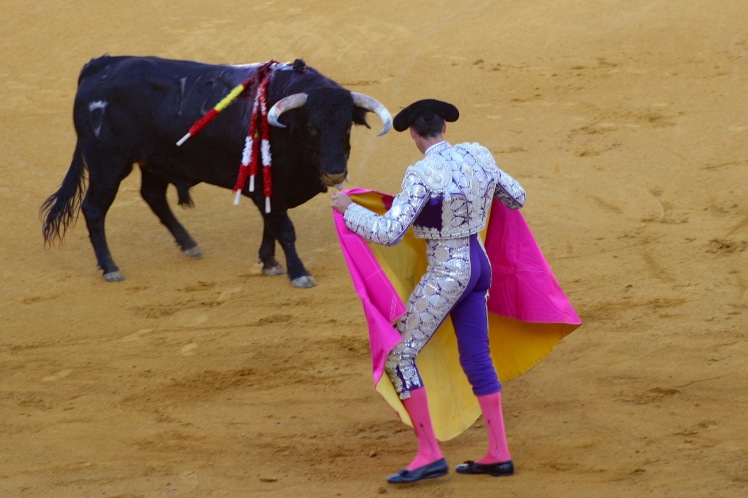
“I don’t know how you can take pictures of this,” I heard Jordyn say from behind her hand. Suddenly, I felt guilty. I felt like taking pictures was wrong. I looked around the audience, I wasn’t the only one with a camera though. Still feeling uncomfortable taking pictures, and suddenly all too aware of my shutter, I shrugged. I didn’t have an answer for her.
A few more passes were made between the matador and the bull. This time I heard the audience start saying something in unison. I had a hard time trying to decipher what they were saying. At first I thought it was Olé, since most people associate that word with Spanish and this seemed like an appropriate place for such a word. As I listened to the crowd repeat the word over and over again, I realized that the word they were saying was only one syllable, so it couldn’t be Olé. I listened harder. Was I hearing hail? Isn’t that an English word? I thought there was no way that’s what I heard but I would learn later that they were saying hail and that the crowd was saying this because the matador was performing one of the most classical of passes. It was called veronica. Many matadors try to put their own spin on the pass. They have an open stance or a closed one and use a range of technical oriented to more expressive interpretation of basic movements.
Eventually, and almost too soon it felt like, it was time for the matador to trade in his fuchsia and yellow cape for the red one. The bells on the mules tingled quietly, a silent promise of the death to come. The matador lured the bull into the center of the ring and gave one last performance with the bull before letting out his battle cry and charging the bull, sinking his sword in between the shoulders and into the heart. I watched this through my viewfinder, though I had stopped taking pictures. It didn’t feel right photographing the bull’s end. I didn’t have the heart to document this strong regal beast, at its weakest moment. I didn’t want to document its surrender. By watching the fight through my viewfinder, I felt a disconnect from what was really unfolding in front of me. When the bull was dead, I put my camera down and looked on with my bare eyes.
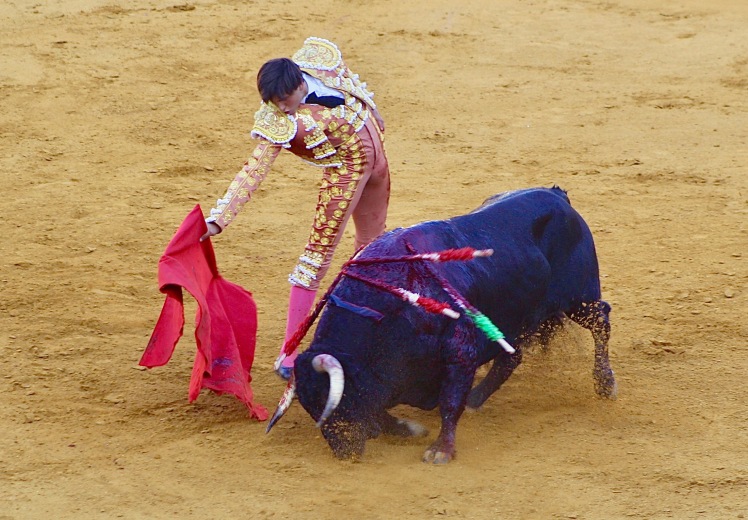
The mules came out and the bull was chained up and dragged out of the ring. Jordyn and Ally were still crying next to me. I looked over at Brittany who was sitting at the end of our row. We exchanged a look. We weren’t sure what to make of this. Muñoz came over to us to see how we were doing. She told Ally and Jordyn that they could leave if they truly couldn’t stand to watch the fight anymore. I had a brief moment of panic when I thought our professor was going to tell us that we could all leave or that we didn’t have to stay for the whole thing, knowing that I was probably the only one who would stay to watch the fight in its entirety.
Jordyn and Ally practically ran out of the stadium, wiping tears from their eyes. I felt embarrassed for them as many Spaniards watched them go un-amused. It was almost as if their looks were saying, That’s right, you don’t belong here, and I couldn’t decide if that was because they were Americans or because they were girls, or both.
With the two of them gone, it was just Brittany and I left on our cement slab of a bench. “How are you guys holding up?” Muñoz asked us.
“Fine,” I said with a shrug. Brittany nodded in agreement. Muñoz gave us two thumbs up and returned back to her seat. Morgan left her place and came to join Brittany and I.
“So, what do you guys think?” she asked as she slid into our row, the third bull entering the ring.
“I don’t know,” I said snapping a few pictures.
“Yeah, I’m not sure,” Brittany said.
“It’s sad but at the same time it’s kind of neat,” I tried to explain. “I love animals, really I do and I don’t condone animal abuse, but this is a part of their culture. Besides they use every part of the bull, it’s not like it gets slaughtered for nothing.” I remembered my ox tail I had at a restaurant just two nights earlier and how thick and tender it was.
This third bull wasn’t black like the other bulls. This one was brown with a lighter back, almost as if it was greying. Having learned that the third matador to go is the one with the least experience, I wondered if this bull was perhaps older and “easier” than a younger bull. This could have been true. I watched the bull fall to his knees at least three times during a pass with the matador, my heart sinking every time.
Once the matador killed this bull I knew we were at the halfway mark and that it was time for the first matador to come out again. Being the one with the most experience, Filiberto got a little daring with his performance. Once he had entered the third stage and traded his cape for the red one, he got on his knees and encouraged the bull to make a pass.
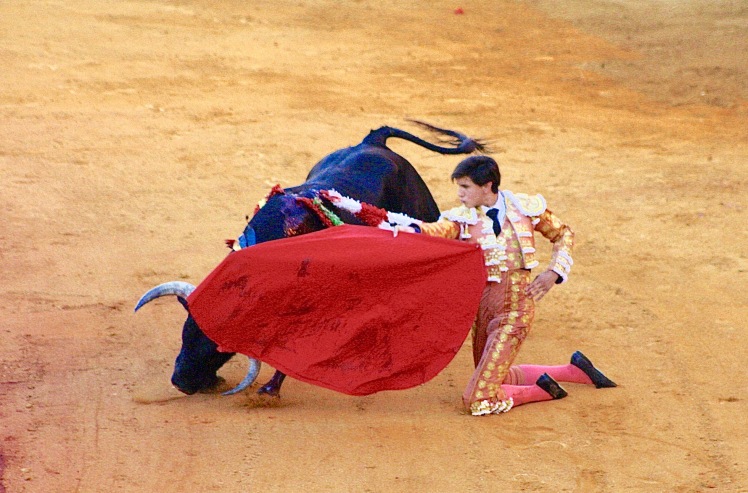
“Oh my God, is he insane?” Morgan said next to me.
“Holy shit” I said. This is where it all goes downhill, I thought to myself. This is when the bullfight turns into all of those clips I’ve seen on TV. I felt bad Ally and Jordyn were about to miss this.
The bull made a pass and then another and then another, Filiberto on his knees the entire time. In one swift motion the bull made another pass and the matador was back on his feet. The audience whistled and cheered. I let out a breath I didn’t know I was holding in.
Just as the matador was maneuvering the bull into a position for the final pass he dropped his cape. Suddenly there was nothing between the bull and the matador, nothing to distract the bull with. Filiberto’s trusty banderilleros came to the rescue with the fuchsia and yellow capes, deterring the bull from the red one that he was currently stomping on. After a few more quick passes, the matador finally made the move and sunk his sword into the bull. Only this time, he missed.

Rather than falling to the ground in defeat, this bull refused. He panted, he bellowed, and he walked on. The banderilleros tried to get the bull to charge again, to get the blood pumping faster, but the bull was not interested. This was not supposed to happen. Death was supposed to be brought quickly to the animal. They were not supposed to suffer. That’s one of the “selling points” in bullfighting.
Blood started dripping from the animal’s mouth. I had stopped taking pictures and looked on in horror, without my viewfinder. I couldn’t look away. It was like a tragedy where your mother tells you not to look, but you do anyway and can’t stop. The bull let out another bellow. Can the other bulls hear him? My vision started to blur. It’s not supposed to be like this. This is wrong. Now I began to feel like the American girl who didn’t have the stomach to watch a bullfight. I began to feel like the one “not worthy” enough of the Spanish culture.

The audience sat on the edge of their seats as they waited anxiously for the end. I don’t think anybody was breathing. The air was eerily still. Too still for an atmosphere that was bustling with excitement just an hour and a half earlier.
When the bull finally collapsed, the matador got the biggest applause I had yet seen, although I’m not sure why because he missed the spot he was supposed to pierce. The animal had suffered. That wasn’t supposed to happen. Not only did I witness another animal die, but I watched it suffer. I watched this animal put in the one last fight he had left in him.
The second matador, Roca Rey, started his performance similarly to how Filiberto ended his. As an intermediate matador, I was surprised when Roca got on his knees and waited for the bull to come out of the shoot at full blast. This time I was sure something was going to go wrong.

“Is he fucking nuts?” Morgan said, “I gotta video this,” and she held up her phone. I got my camera ready and kept my finger on the shutter button as the bull stormed out of the shoot and right for the matador. Surprisingly enough, they made three clean passes and the matador was able to get to his feet, but only for a second. In the blink of an eye he was on the ground and the bull was on top of him.

“Oh shit, oh shit, oh shit, oh shit,” Morgan said next to me while still recording. I kept snapping pictures. One of the banderilleros rushed out with a cape to distract the bull and the matador was able to get up again and continue on with his performance. This bull was fierce. When it was time for the picadors to come out, the bull needed very little enticing to charge the horse and when he head-butted the horse, he lifted it up a little and continued pushing. The picador lost his steel protective stirrup and began to slide off the opposite side of the horse. I thought for sure that he was going to fall into the dirt. If he falls will the bull attack him? Or the continue attacking the horse?
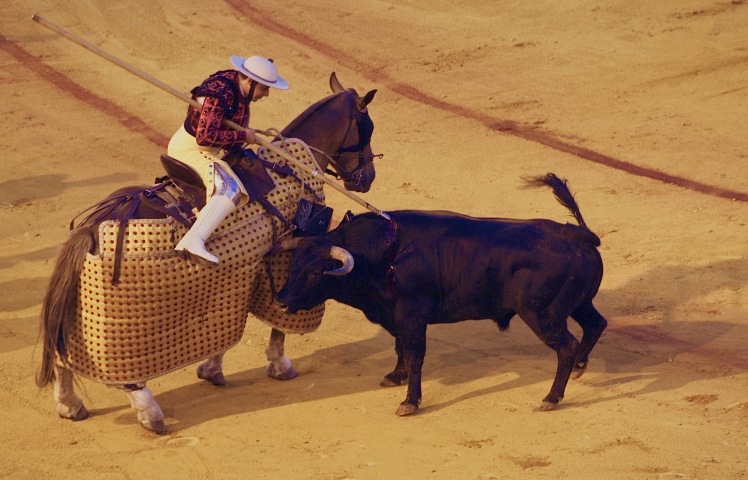
The matador was able to lure the bull back into the middle of the ring before the picador could fall and things got too interesting. The bull pawed the ground and bellowed before charging the matador. It was as if the picador didn’t have any affect on the bull at all whatsoever. The bull was still strong and full of life. There was no sign of deterioration.
When it was time again for the banderilleros to stick the banderillas into the bull, the first banderillero was thrown to the ground. The bull was on top of the man in no time. In the mess of dust and horn I thought for sure he was going to be gored. Two more men with capes ran out to redirect the bull, one lost his cape, while the other tried to redirect the bull in the direction of the matador. He made a few passes before the rest of the banderillas were placed into the bull.

The matador then brought the bull into the center of the ring for the final stage of the fight. He made beautiful, artistic passes, the red cape fluttering in the wind with each pass. Just as the matador was ready to maneuver the bull into the killing position, the bull turned on him and ran him into the ground again. This bull was not going down without a fight. I continued to rapid fire my camera, hoping to get a good shot. I was finally seeing what I saw on TV. Morgan continued videoing next to me.
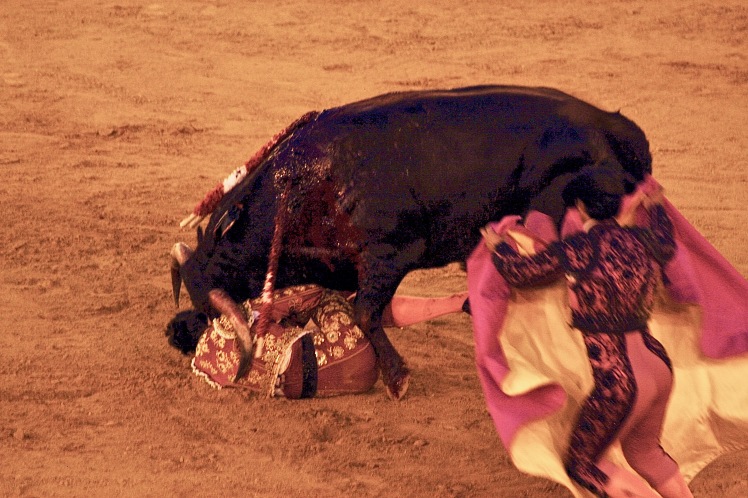
A banderillero had to come save the day again as the bull viciously shook his head on top on the matador. I did not think this matador was going to get up again, but he did and when he did, he brushed himself off and walked a small circle, saluting the audience. He was limping and bleeding from his thigh, although it was hard to tell whose blood was whose, but he stood straight and proud nonetheless. He was going to finish the fight. Suddenly there seemed to be a mutual understanding between the bull and the young matador and the strength each one of them possessed. The fight went on and when the bull fell into the dirt, the audience roared, waved their white towels and gave a standing ovation, one of the highest compliments a matador could receive. The matador was also given the ear of the bull, another huge compliment. He limped a victory lap as the audience continued to applaud.

“Ugh, he’s so pompous,” Morgan sneered watching the matador limp his victory lap, the ear of the bull high in his right hand.
When the fight was over and everyone stood, Brittany and I exchanged a look. I still wasn’t sure how I felt about the fight. I understood the cultural aspect behind it, but I’m not sure how I felt about killing bulls for sport, or rather “art.” I came to the conclusion that this was not something that I would take my mother to if she were to ever visit me in Spain, however, I think this was something that I would go to again. There was something in the atmosphere that I loved and will never forget.